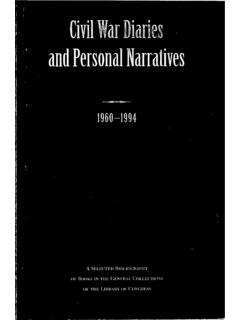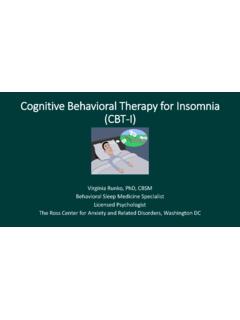Transcription of Overview of UbD & the Design Template
1 Understanding by Design Overview of UbD &. the Design Template 09/2005. Grant Wiggins Understanding by Design Intro Stage 1 Stage 2 Stage 3 resources Template UbD Template - with question Stage 1 Desired Results prompts Established Goal(s): G. What relevant goals ( , Content Standards, Course or Program Objectives, Learning Outcomes etc.) will this Design address? Understanding(s): U Essential Question(s Q. Students will understand What are the big ideas ? What provocative questions will foster inquiry, understanding, and What speci c understandings about transfer of learning? them are desired? What misunderstandings are predictable? Students will Students will be able K S. What key knowledge and skills will students acquire as a result of this unit?)
2 What should they eventually be able to do as a result of such knowledge and skill? Stage 2 Assessment Evidence Performance Task(s): T Other Evidence: OE. Through what authentic performance Through what other evidence ( task(s) will students demonstrate the quizzes, tests, academic prompts, ob- desired understandings? servations, homework, journals, etc.). will students demonstrate achieve- By what criteria will performances ment of the desired results? of understanding be judged? How will students re ect upon and self-assess their learning? Stage 3 Learning Plan Learning Activities: L. W = help the students know where the unit is going and what is expected? Help the teacher know where the students are coming from (prior knowledge, interests)?
3 H = hook all students and hold their interest? E = equip students, help them experience the key ideas, and explore the issues? R = provide opportunities to rethink and revise their understandings and work? E = allow students to evaluate their work and its implications? T = be tailored (personalized) to the different needs, interests, abilities of learners O = be organized to maximize initial and sustained engagement as well as effective learning? 2003 ASCD and Grant Wiggins & Jay McTighe page 2. Understanding by Design Intro Stage 1 Stage 2 Stage 3 resources Template # Unit Design , Before & After Prairie Day A Typical 3rd-Grade Social Studies Unit Topic Topic: Westward Movement and Pioneer Life (social studies - 3rd grade). Activities a.
4 Read textbook section - life on the prairie. Answer the end-of- chapter questions. b. Read and discuss Sarah Plain and Tall. Complete a word search . puzzle of pioneer vocabulary terms contained in the story. c. Create a pioneer life memory box with artifacts showing what life might be like for a child traveling west or living on the prairie. d. PRAIRIE DAY activities: Dress in pioneer clothes and complete sev- en learning stations: 1. churn butter 2. play 19th-century game 3. send letter home w/ sealing wax 4. play dress the pioneer computer game 5. make a corn husk doll 6. quilting 7. tin punching Assessments a. quiz on pioneer vocabulary terms from Sarah Plain and Tall b. answers to end-of-chapter questions on pioneer life c.
5 Show and tell for Memory Box contents d. completion of seven learning stations during Prairie Day e. student re ections on the unit page 3. Understanding by Design Intro Stage 1 Stage 2 Stage 3 resources Template Stage 1 Desired Results Established Goal(s): GA SS4H6 The student will explain westward expansion of America G. between 1801 and 1861. a. describe territorial expansion with emphasis on the Louisiana Purchase, the Lewis & Clark expedition, and the acquisitions of Texas (the Alamo and inde- pendence), Oregon (Oregon Trail), and California (Gold Rush and the development of mining towns) b. describe the impact of life in America. Understanding(s): U Essential Question(s Q. Students will understand Why do people move? Why did the pio- Many pioneers had naive ideas about the neers leave their homes to head west?)
6 Opportunities and dif culties of moving West. How do geography and topography affect People move for a variety of reasons -- travel and settlement? for new economic opportunities, greater Why did some pioneers survive and freedoms or to ee something. prosper while others did not? after backward Design Successful pioneers rely on courage, What is a pioneer? What is pioneer spirit ? ingenuity, and collaboration to overcome What was pioneer life really like? hardships and challenges. Students will Students will be able key facts about the westward move- K recognize, de ne, and use pioneer S. ment and pioneer life on the prairie vocabulary in context pioneer vocabulary terms use research skills (with guidance) to nd basic geography ( , the travel routes of pio- out about life on the wagon train and prairie neers and location of their settlements) express their ndings orally and in writing Stage 2 Assessment Evidence Performance Task(s): T Other Evidence: OE.
7 Create a museum display, including artifacts, pictures, oral and/or written response to one of and diary entries, depicting a week in the life of a the Essential Questions family of settlers living on the prairie. (What common misunderstandings do folks today have about prairie drawing(s) showing hardships of pioneer life life and westward settlement?). test on facts about westward expansion, Write 1 letter a day (each representing a month of travel) to a friend back east describing your life on life on the prairie, and basic geography the wagon train and the prairie. Tell about your hopes and dreams, then explain what life on the frontier explanation of the memory box contents was really like. (Students may also draw pictures and explain orally.)
8 Stage 3 Learning Plan Learning Activities: (selected). Use K-W-L to assess students' prior knowledge and identify learning goals for the unit. L. Revise Prairie Day activities ( , substitute Oregon Trail 2 computer simulation for dress the pioneer . and ask for journal entries while the simulation is played). Include other ctional readings linked to the identi ed content standards/understandings ( , Little House on the Prairie, Butter in the Well). Create a timeline map of a pioneer family's journey west. Add non- ction sources to accommodate various reading levels, such as Life on the Oregon Trail, diaries of Pioneer Women, and Dakota Dugout. Guide students in researching the period using a variety of resources. Review the scoring rubrics for memory box, museum display, letters, and journals before students begin the performance tasks.
9 Include opportunities for students to study examples of these products. 2003 ASCD and Grant Wiggins & Jay McTighe page 4. Understanding by Design Intro Stage 1 Stage 2 Stage 3 resources Template # Unit Design , Before & After A Typical 10th-grade Geometry Unit Topic/objectives before backward Design : textbook coverage-oriented Topic: Surface Area and Volume (HS geometry). know how to calculate surface area and volume for various 3-dimensional gures know and use Cavalieri's Principle to compare volumes know and use other volume and surface area formulae to compare shapes Lessons/Activities Read Chapter 10 in UCSMP Geometry Go through all the formulae and examples Exploration 22, p. 482 Containers holding small amounts can be made to appear to hold more than they do by making them long and thin.
10 Give some examples.. Assessments a. odd-numbered problems in full Chapter Review, pp. 516-519. b. progress self-test p. 515. c. homework: each 3rd question in sub-chapter reviews and completion of the explorations page 5. Understanding by Design Intro Stage 1 Stage 2 Stage 3 resources Template Stage 1 Desired Results Established Goal(s): NH Math Standards G. 4a. K-12 Broad Goal: Students will name, describe, model, classify, and compare geometric shapes and their properties with an emphasis on their wide applicability in human activity. 1a. K-12 Broad Goal: Students will use problem-solving strategies to investigate and under- stand increasingly complex mathematical content. Understanding(s): U Essential Question(s Q. Students will understand How well can pure mathematics model The adaptation of mathematical models messy, real-world situations?)








